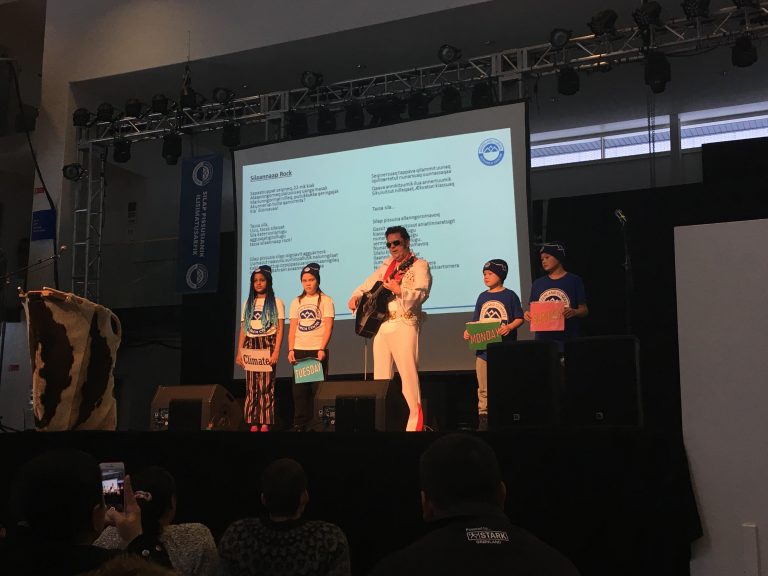NASA succeeds in finding “cooling” at Ilulissat Published 28.02.2019

Contrary to some expectations, scientists from NASA found evidence of cooling last year in Greenland where the ice sheet has actually grown thicker in places, and glaciers has started to grow again. One of these places is the Kangia glacier at Ilulissat. In the last two years, it has been growing upwards and outwards towards the coastline.
“It is extremely interesting for us, as scientists, to find places where after 20 years of melting, the ice is suddenly growing again. We are pretty sure that it must be a temporary change. But watching it play out will give us a sense of what will happen in the long run, when things warm up again”, says NASA (National Aeronautics and Space Administration) oceanographer Josh Willis.
Recently, Willis was in Nuuk in connection with the Greenland Climate Centre’s celebration of its 10th anniversary where he gave a talk about the consequences of climate change for the seas around Greenland and the Greenland Ice Sheet.
NASA is keeping an eye on climate conditions in Greenland
NASA has been following developments in the ice sheet through satellite observations since 1978, NASA has been able to observe temperatures on the ice sheet and the areas that were melting. From the early 1990s, satellites started to also observe how fast the glaciers moved. By the beginning of the 2000s, NASA was also able to measure the ice sheet’s weight and even figure out how much ice is lost each year from the whole ice sheet.
However, according to Willis, NASA has not yet solved all of Greenland ice sheets riddles. Also, NASA would like to gain more insight on which of the glaciers that are being affected by the oceans, and how much they are being affected.
Therefore, NASA has launched a five-year project called OMG – Oceans Melting Greenland –, which has been running since 2015 in Greenland. Here, NASA will collect data intensively in order to gain a better understanding of the impact of climate change on the seas around Greenland and their interaction with ice sheet melt until 2020.
Regime change in the Atlantic Ocean
The very cold summers of the past two years in the west coast of Greenland were seemingly caused by the previously mentioned regime change in the Atlantic Ocean. Like all natural environments, seas are subject to changes in temperature, salinity and other conditions. The Atlantic Ocean has been shown to exhibit roughly two-decade long cycles of alternating colder and warmer regimes. Precisely in 2015/2016, the Atlantic Ocean was shifting from warmer to colder water. As a result, cold water flowed up along Greenland’s west coast all the way to Melville Bay. This in turn resulted in cooling. For the first time, scientists from NASA have actually observed a cooling in the waters offshore of West Greenland, following 20 years of increasing temperatures, says Willis.
Scientists have observed this in the waters near the glacier of Kangia near Ilulissat, among other places. The glacier is known to be the most productive glacier in the northern hemisphere, calving somewhere around 20 million tons of ice a day.
The Kangia experiment may pave the way to better climate predictions
“The impact of the sea on ice sheet melt is the hardest thing to predict. We have quite good calculations of how much melt will be caused by air, but the interactions with the seas we are only just beginning to understand. If melting should proceed much faster than we expected, the cause will undoubtedly be the impact of the sea. With OMG, we hope to understand how sensitive the ice sheet is to warming of the seas”, Willis explains.
Willis goes on to say that if they can find the answers to their questions, the next step for NASA is to produce model calculations for use, for example, in a series of predictions of conditions concerning melting of the ice sheet and what might happen to the seas. To this end, scientists at NASA will use the data collected from the Kangia glacier, along with many other glaciers to the north, and scale them into models showing what might happen, and when it might happen, in the wake of climate change.
“Climate change is ongoing, and we have never seen events such as these before. So we have nothing to compare them with. With OMG, we are trying to better understand how climate change is unfolding”, Willis emphasises.
It is no wonder that the melting of the Greenland Ice Sheet has attracted so much interest around the world. New data from NASA show that over the past 15 years, Greenland has become 3 trillion tons of ice “thinner”, and contributed about 1 cm to global sea level rise (of about 4.5 cm total) during that time. There is still some way to go, as the oceans will rise 7.5 meters if the entire ice sheet should melt away.

Climate Elvis and Hinnarik is having fun after their stage performances on the “Climate Day” in connection with the Greenland Climate Centre’s celebration of its 10th anniversary in the national Greenlandic cultural center 1th of February 2019. The oceanographer of NASA in USA, Josh Willis, alias Climate Elvis sang the real Elvis´ “Jailhouse Rock” switched with his own lyrics about consequences of the climate change. Climate Elvis performs just this one song to reach out with his climate messages in an alternative way – he sure create attention. Photo: Peter Hegelund, Greenland Institute of Natural Ressources.
FACTS about the Greenland Ice Sheet
The vital importance of glaciers
A large part of the ice sheet runs straight into the sea in the form of glaciers. Some of these can be enormous and can sit on the bedrock at depths of 1000 meters under the sea. According to NASA oceanographer Josh Willis, Greenland can be divided into four parts, and he estimates that 1/3 of Greenland, primarily from Cape Farewell to Disko Bay does not have many glaciers left that reach the sea, while the remaining areas have many. Willis further estimates about 1/4 of glaciers reach the sea and sit in water that is deep.
Glaciers are of vital importance when it comes to creating upwelling in the sea and thus to biological primary production, which forms the basis of marine life.
When the surface of the ice sheet melts, a large amount of water runs out at the bottom of the ice sheet and reaches the sea underneath the glaciers. This means that lighter fresh water from the melt ends up below the heavier, warmer, nutrient-rich and saline sea water. This causes the melt water to roll upwards, bringing nutrient-rich sea water with it to the sea surface. Thus, nutrients are brought up into the light where primary production takes place – first phytoplankton, then zooplankton, which in turn provides nourishment for the remaining links in the food chain; the cycle of marine life.
Collaboration between Greenland Institute of Natural Ressources and NASA
In 2012, the Greenland Climate Research Centre initiated a project together with hunters from Savissivik and Kullorsuaq to study the glaciers in Melville Bay and the fauna, especially narwhals, associated with them. Since 2017, the Greenland Climate Research Centre has been collaborating with Joshua Willis’ group OMG-NASA (Oceans Melting Greenland) on this project. The joint project has been given the humorous name OMG-Narwhals and will continue at least through 2020.
The tipping point
It is said that the Greenland Ice Sheet can melt to a point where the melt becomes unstoppable. Scientists call it “The tipping point”. It remains unknown where this point is, and when it will be reached, says NASA oceanographer; Josh Willis.

